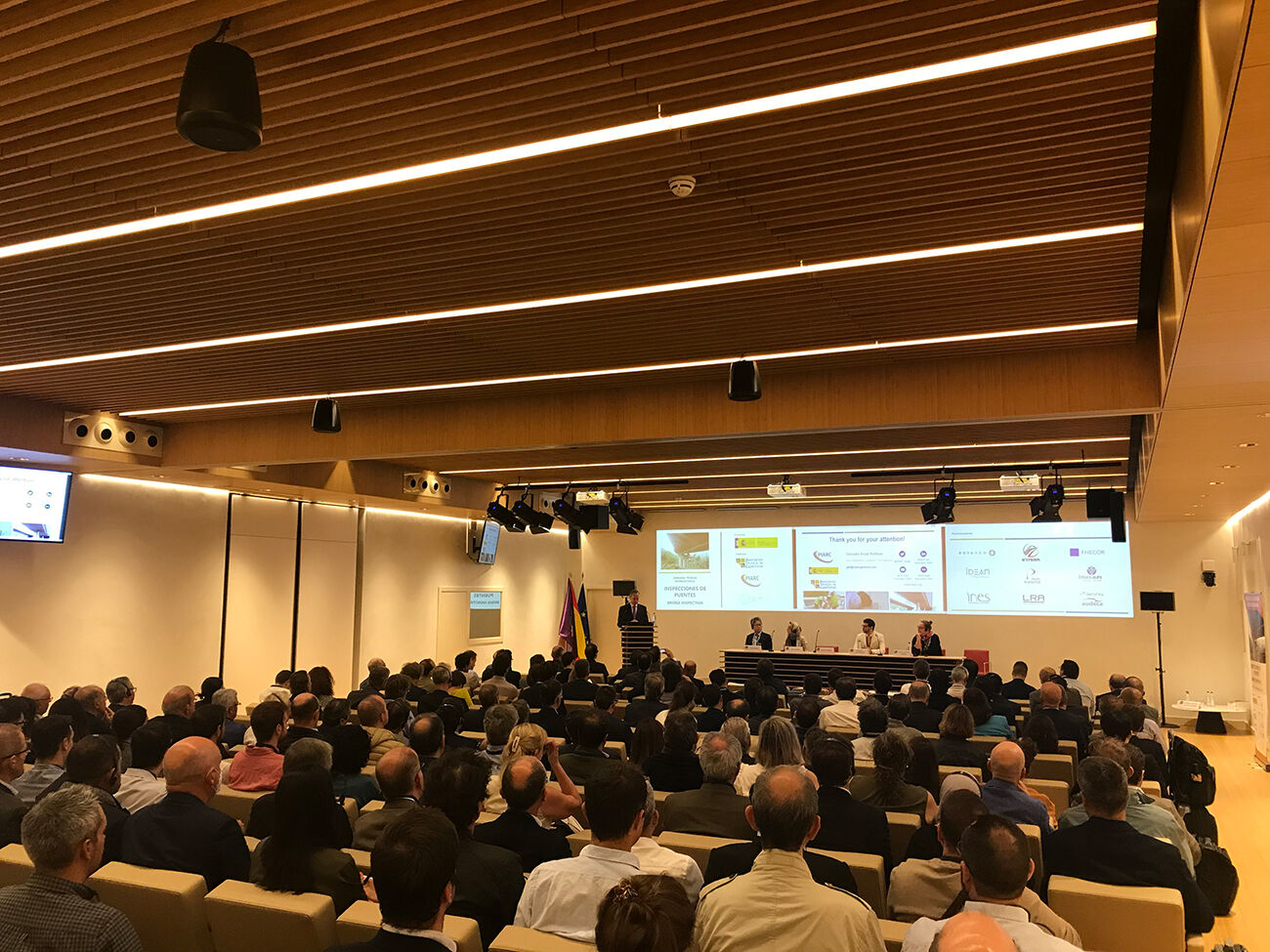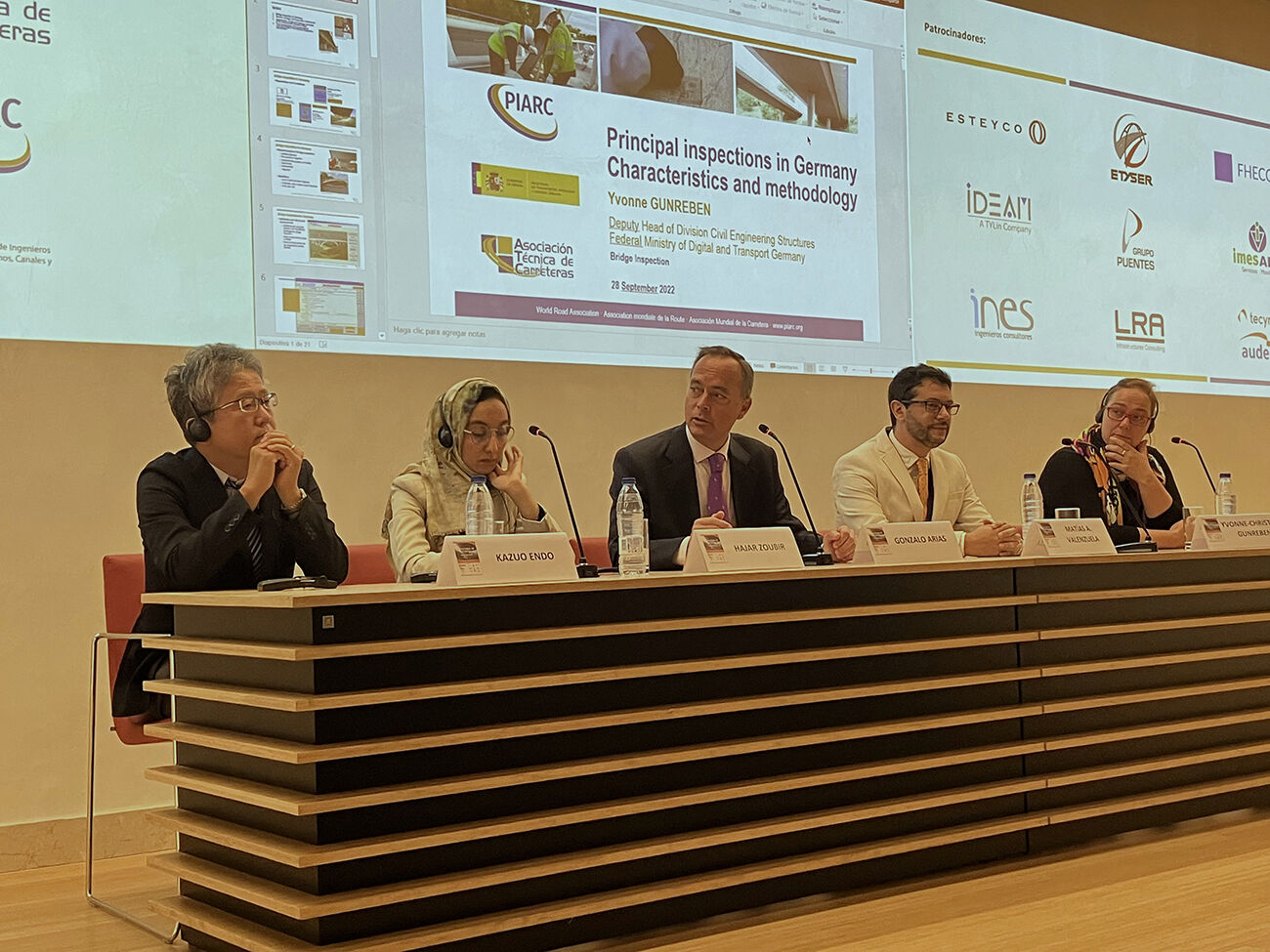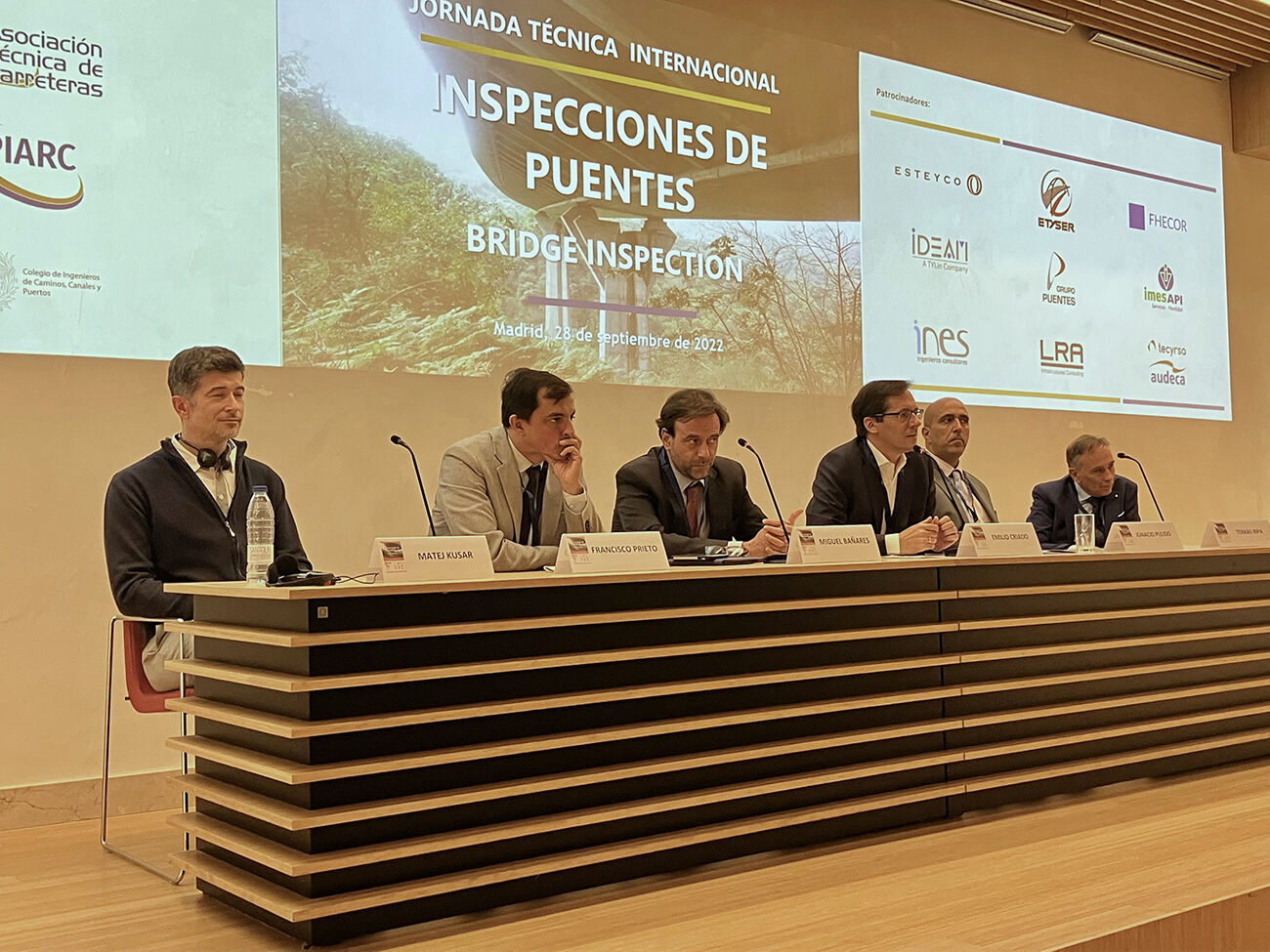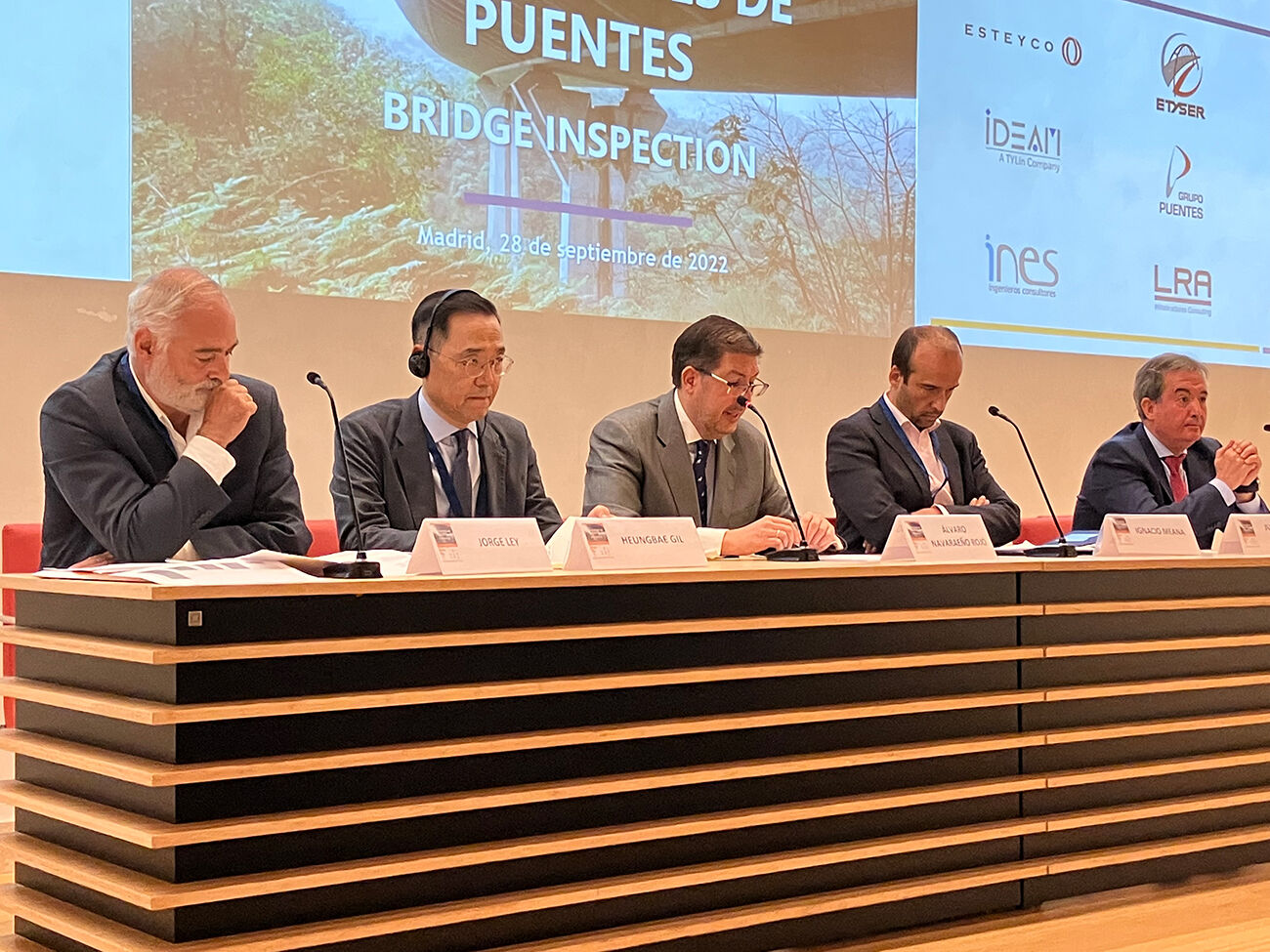International Workshop "Bridge inspection"
28 September 2022, Madrid (Spain)
On September 28, in Madrid (Spain) in collaboration with PIARC, its National Committee in Spain, Asociación Técnica de Carreteras, and the College of Civil Engineers of Madrid, an International Technical Seminar on Bridge Inspection was held, with great success. 25 members of PIARC International Technical Committee 4.2 "Bridges" and just over 200 attendees from the Spanish technical community have participated.
Although it may seem like a topic that has already been widely discussed in the literature and other technical events, the fact of being able to learn about the experience in other countries and the recent events that have occurred in some bridges all around the World seem to have been two reasons enough to achieve a renewed interest in bridge inspections.
Summary of the Workshop
The day was divided into two sessions and a final round table. The first session presented different bridge inspection methodologies applied in 8 countries that volunteered within the PIARC Technical Committee 4.2 "Bridges" (Germany, Austria, Chile, China, Spain, Japan, Morocco and Portugal). It was applied to two case studies prepared by Spain. These were two bridges belonging to the Spain’s National Highway Network: a 4-span overpass with a deck of precast prestressed concrete beams and another 4-span overpass with a composite steel-concrete deck, for which information had been compiled and shared (inventory information, as built drawings and the last principal inspection carried out), so that each country could know the main deterioration detected in each case. Based on this information, each country developed a virtual principal inspection applying its own methodology. Within the 8 countries that presented one or both examples, 4 of them have been chosen (Germany, Chile, Japan and Morocco, representing 4 continents) to make a brief presentation of their methodology and the results of the practical inspection case on one of the two examples given. For the remaining 4 countries, the moderator of the session made a brief presentation summarizing the main characteristics of their methodologies and results obtained, ending with some conclusions comparing different aspects in the way of carrying out the principal inspections of bridges in terms of frequencies, evaluation of the condition of the bridges, content and detail of the inspections and other data of interest.
The second session was dedicated to special inspections of bridges and was divided into four presentations given by the representatives of the companies that currently carry out the principal and special inspection campaigns for the Ministry of Transport, Mobility and Urban Agenda throughout Spain. The first presentation was dedicated to the inspection of cable-stayed bridges and box-girder bridges with external prestressing, explaining the different techniques and tests applied to each case. Next presentation described a series of recent cases of singular problems analyzed in special inspections (bridges of different typologies: girder bridges, metal trusses, concrete slab bridges, etc.) and the decision-making adopted in each of them. The third speaker also dedicated his talk to presenting a series of interesting recent cases in other types of bridges (corrugated steel tubes, composite bridges) and elements such as expansion joints, half-through joints (Gerber connections) and bearing devices. Finally, the fourth presentation reflected on the importance and critical consequences of certain damages, and how their presence individually or jointly can modify the decision applied in each case. The session closed with a presentation by Matej Kusar from Slovenia on new bridge inspection techniques and technologies, including case studies on investigation and monitoring of deteriorated bridges. The presentation was based on work coordinated jointly with Gonzalo Arias from Spain in TC 4.2, which resulted in a recently published PIARC report that has proven of great interest to the bridge inspection community.
Late in the morning, a round table moderated by Álvaro Navareño from Technical Committee 4.2 "Bridges" and President of the Bridge Committee at the Spain’s Local Committee of PIARC, with one representative of the Spanish Railway Company ADIF, another representative of the Spanish Chamber of Civil engineers, a third representative from the private sector in engineering consultancy and Heungbae Gil, representative of South Korea in the PIARC TC 4.2. The round table was dedicated to the effects of climate change on bridges and how through bridge inspections these effects can be verified and anticipated, leaving a shared reflection that it is no longer a forecast, but a reality that it will only increase in the coming years.
| International Workshop Program - 29 September 2022 Bridge Inspection |
|---|
Opening session (9:00-9:15) |
Welcome remark : Javier Herrero Lizano, PIARC First Delegate of Spain
Welcome remark : Mª del Rosario Cornejo, ATC President
Welcome remark : Ricardo Martín de Bustamante, CICCP Vice President
- Welcome remark : Kiyohiro Imai, President, TC 4.2 Bridges, PIARC
Welcome remark : Alvaro Navareño, Bridges Committee President, ATC
Session 1 (9:20-11:20) |
The principal inspections in Morocco - Characteristics and methodology - Hajar Zoubir, Bridge Engineer/Bridge Inspector, national Center of Road Studies and Research, general Road Directorate (Morocco)
The principal inspections in Chile. Characteristics and methodology - Matías A. Valenzuela, Structural Advisor, bridge Department, ministry of Public Works, head of Civil Construction Engieneering – PUCV (Chile)
The principal inspections in Germany. Characteristics and methodology - Yvonne-Christine Gunreben, Deputy Head of Division Civil Engineering Structures, federal Ministry of Digital and Transport (Germany)
- The principal inspections in Japan. Characteristics and methodology - Kazuo Endo, Honshu Shikoku Bridge Expressway Co. Ltd. (HSBE), general Manager of Shimanami-Onomichi Operation Center ( Japan)
Summary of other contributions - Gonzalo Arias, INES Ing., moderator, Head of Maintenance Department – INES Ingenieros
Session 2 (11:45-13:45) |
Special inspections of cable-stayed bridges and externally prestressed - Miguel Bañares, Head of Structures Department (Esteyco)
A step beyond special inspections: recommendations and decision making - Ignacio Pulido, IDEAM member
Recent experiences in the special inspections carried out in the 15 Itinerary-South Zone - Francisco Prieto, member of FHECOR, INTEMAC and TYPSA
- Critical damage and their study in a special inspection - Tomás Ripa, member of LRA and AECOM
New Inspection techniques - Matej Kušar, DRI member (Slovenia)
- Colloquium
Roundtable Discussion (13:45-14:20) |
Closing session (14:20-14:30) |
Technical conclusions of the workshop
One of the main conclusions of the workshop was that if we want our structures to age slowly and be durable, it seems that the rational path leads us to continue listening to bridges through continuous inspections, to anticipate problems, and knowledge of other ways of carrying out this work helps us to improve in our current approaches.




